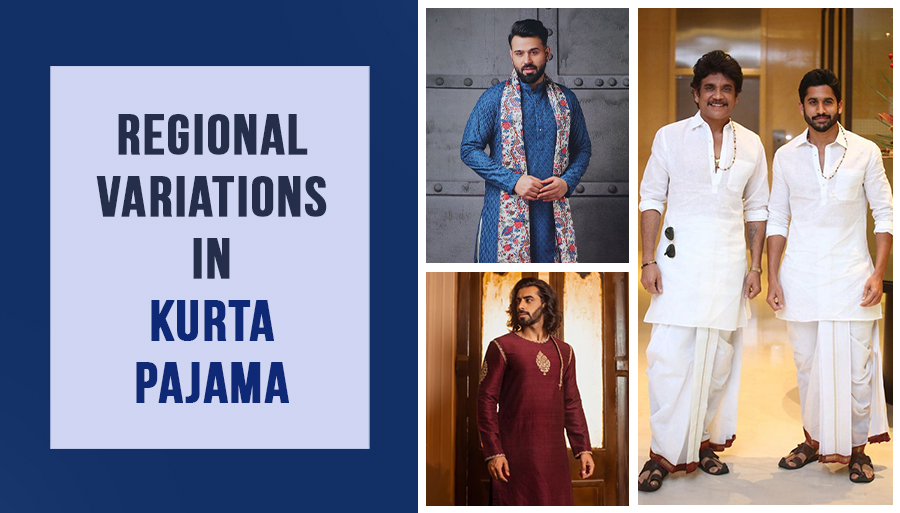As traditional men’s wear, Kurta pajama is known for its versatility and enduring charm. It is the traditional outfit for men that you can see men flaunting on all occasions across South Asia and beyond. It boasts of an aesthetic appeal that can adapt to the mood and charm of different occasions. The wide variety of kurta pajamas with different regional twists represents a unique fashion ensemble. Each region in India and Southeast Asia represents a unique style and widens the fashion choices with different design elements, fabrics, cuts, and embellishments.
This blog will explore the diverse regional variations of men’s kurta pajamas.
Kurta Pajama from North Indian States

The North Indian states are where the kurta pajama originated and are rightly considered the heartland of this fashion outfit. No wonder, throughout North India, kurta pajamas are worn on different festive occasions, weddings, and social events.
Some of the distinct styles, fabrics, colors and design elements of North Indian kurta pajamas include the following.
- Design: North Indian kurtas typically have extended long cuts and are mostly tailored for a straight fit. Other design elements often showcase detailed embroidery work and intricately designed necklines and cuffs.
- Fabric: North Indian kurta pajamas are mostly made of cotton and silk, though people sometimes prefer heavier materials like brocade and velvet. Silk and velvet kurtas are normally preferred for weddings and festive occasions.
- Colors: Regarding the preferences of colors, the options are huge. North Indian men prefer white, cream, and pastel shades for daytime and festive wear. Maroon and royal blue shades dominate the men’s kurta pajama for weddings and nighttime events.
- Pajama Style: Men from North India prefer churidar for pajamas while straight-fit pajamas are also popular.
- Distinct Regional Styles: Some popular regional styles within North India include the Lucknowi kurta pajama, which features chikankari embroidery, and the Banarasi kurta pajama, which is made from luxurious Banarasi silk and features intricate designs.
Vibrant Punjabi Kurta Pajama

Regarding the Punjabi variety of kurta pajamas, vibrant hues remain the signature element. Showcasing the lively and spirited culture of the region kurta pajamas of Punjab became popular all over India.
Some of the distinct style elements that make Punjabi kurta pajama so special include the following:
- Length & Cut: Punjabi kurtas are often shorter than North Indian varieties. These short kurtas are often worn with loose pajamas called salwars.
- Fabric: For Punjabi kurta pajamas, cotton and khadi remain the most popular fabrics. But silk and satin also appear as choices for special occasions, particularly weddings and festivals.
- Design elements: Punjabi kurtas often feature bright patterns, detailed phulkari embroidery, and bold, vibrant prints.
- Choice of Shades: Men in Punjab mostly prefer bold and vibrant hues for kurtas. Some of the most popular shades that frequently appear in Punjabi kurta pajamas include red, yellow, green, and orange.
- Popular regional varieties of Punjabi kurta pajama: Some distinct styles and varieties that frequently appear in kurta pajamas from the Punjab region include Phulkari kurta pajama and traditional tamba kurta.
Rajasthani Kurta Pajama

Men’s kurta pajama from Rajasthan brings us the exquisite grandeur of the kingly fashion sentiment for the modern palette. If you have a soft corner for the extraordinary elegance of Royal fashion outfits, this regional variety can make the right choice.
The following are some of the most distinctive style elements, fabric choices, and colors that appear in Rajasthani kurta pajamas.
- Length & Cut: Rajasthani kurtas are mostly long and feature flared hems. They are mostly paired with churidar.
- Fabric choices: Silk is often the most recurring fabric in Rajasthani kurta pajamas. At times, brocade and velvet are also used as other fabric options.
- Design Elements: Intricate embroidery is the most common design element. The most common design traditions that appear include gota patti work, zari embroidery, and mirror design.
- Popular Shades: Rajasthani kurtas often come in bright and rich shades and the most popular choices are maroon, gold, turquoise blue, and emerald green.
- Regional varieties within Rajasthani Kurta Pajamas: Some popular regional varieties within the Rajasthani tradition include Angrakha kurta, with its unique overlapping style, and Bandhani kurta pajama, with its distinct tie-dye patterns.
South Indian Kurta Pajama

South India gives the kurta pajama outfit a different twist by emphasizing simplicity and comfort. No wonder, South Indian men often prefer it to create a simple yet elegant fashion statement.
The following are some of the distinct and recurring styles, fabric choices, and design elements for South Indian kurta pajamas.
- Length & Cut: South Indian kurtas are generally shorter in length and fit close to the body. They are frequently paired with dhotis and, in some places, lungis, replacing traditional pajamas.
- Fabric Choices: Kurtas worn by South Indian men are made of lightweight and breathable fabrics such as cotton and linen. Cotton is the favorite choice because of the comfort it offers in hot and humid weather conditions.
- Choice of Shades: The two most popular shades of kurtas in South India are white and off-white. When worn at weddings, kurtas are often paired with gold-bordered dhotis.
- Design Elements: South Indian kurtas are designed following minimalistic styles such as using patches of embroidery or delicate zari work.
- Regional styles within South Indian kurta pajamas: The most popular regional varieties of South Indian kurta pajamas include Mundu Kurta from Kerala and Pure Silk kurta pajamas.
Bengali Kurta Pajama

On the other hand, Bengali kurta pajamas are stylish choices for cultural and educated men, especially when they attend festivals and public events.
Some of the distinct style elements, fabric choices, choice of shades, and design elements that appear in Bengali kurta pajamas include the following.
- Length & Cut: Bengali kurtas are known for their unique loose-fitting silhouette. Straight-cut loose pajamas are the most popular choice for bottom wear.
- Fabric choices: Cotton and tussah silk are the two most common fabrics used in Bengali kurta pajamas, both representing Bengal’s well-known textile tradition.
- Choice of Colors: Both white and off-white are the most popular shades and these shades often showcase the contrasting gold or bright-colored threadwork or embroidery.
- Regional varieties within Bengali kurta pajama: Some regional varieties within the Bengali kurta pajama tradition that need to be mentioned include the Dhuti kurta pairing of a kurta with a dhoti and Kantha work kurta that features distinct hand-stitched embroidery work.
Conclusion
The evolution of the kurta pajama over the years shows that it is not just any fashion outfit. It reflects a full-blown canvas mitigating a wide variety of fashion traditions. From the vibrant phulkari design work of Punjabi kurta to the regal zari work in Rajasthani kurta to the minimalist design in Bengali kurta pajamas, the horizon is vast. Kurta pajama as an outfit allows you to celebrate various fashion tastes and craftsmanship.
If you are attending a wedding, you have the most intricately designed opulent kurta pajama choice. Or, when you are attending a festival, you can bring your appearance a distinct festive joy through bright colors without overdoing the design elements. These regional kurta pajama varieties offer every different fashion choice you can think of.

